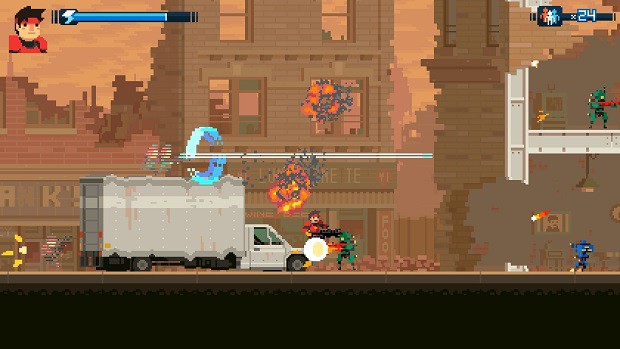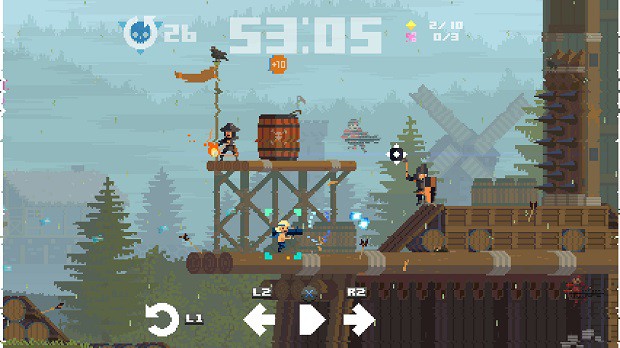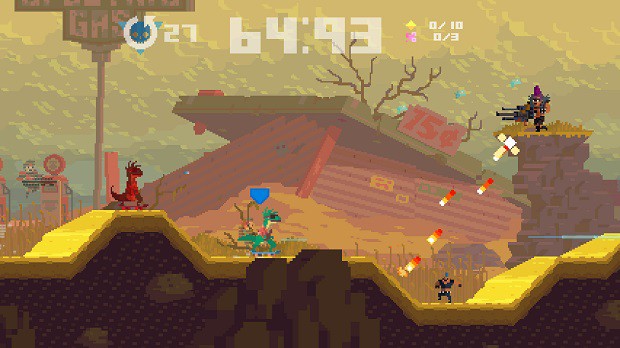How Super Time Force Lets You Play With Paradoxes
A pile of paradoxes
This is The Mechanic, where Alex Wiltshire invites developers to pauses, rewinds and dissect the systems that make their games tick (tock).
Here are the five stages of first playing Super Time Force:
1. It’s just another arcade run and gunner.
2. Huh, I play alongside my former lives?
3. Causality, paradoxes? And a time limit? Oh god.
4. I CAN REWIND TIME.
5. Haha skateboarding dinosaur
It turns out that Capybara Games’ experience of making Super Time Force mirrors that of a player’s first hour or so, except, you know, stretched over three years. In fact, it sounds like it nearly broke its creators’ brains, as they tried to grapple combining a Contra-style platformer with time travel, and getting it to both function on a computer and make some kind of sense in a player’s head.
The story of how Capybara arrived at Super Time Force’s eventual design is a model of the complexity of making games and planning time travel. And it took them well over a year before they even arrived at Super Time Force’s amazingly empowering core principle:
THE MECHANIC: Time Out
So, in a level in Super Time Force you can at any point stop the action, rewind time, and play from where you choose with a new character. All your previous ghosts continue to play out, running, jumping, taking out enemies – but you can introduce paradoxes by making the time flow differently. You can prevent previous ghosts from getting killed, unlock collectibles before your ghosts did. Super Time Force is a game that’s pretty much all about filling the screen with bullets and bodies and managing the chaos of causality that results.
It came out of an entry for 2011’s Toronto Game Jam. The jam’s theme was ‘what just happened?’, and, inspired by Super Meat Boy and Trackmania replays, programmer Kenneth Yeung and artists Mike and Vic Nguyen interpreted it as, “What if you could rewind time and do it over again?”
The demo was pretty simple, having you playing alongside your previous playthroughs and restarting from the beginning when you died. “When I played the prototype for the first time, seeing all these ghosts, my brain couldn’t latch on to everything and I was confused,” says Dan Vader, who joined the project as a designer and writer when Capybara decided to build it into a full game. “But suddenly it clicked and I got it.”
One of the things on which players seemed to fixate was the idea of saving ghosts. By taking out their killers early, their ghosts could be prevented from ever getting hit. But what to do with those saved ghosts lives? Should they continue running around, governed by AI? That would be tricky, so Yeung, Vader and the team went for a simpler solution – it would give you a 1up, to lend explicit value in saving them. “And that was interesting because as soon as we did that it became a mini objective,” says Yeung. “It was this really intuitive, natural hook, and it became the main hook of the game.”
But there was a problem. Players would purposely kill lots of their former selves and then save them in order to get practically infinite numbers of lives. Aside from being a pretty bad exploit, it could also lead to the technical problem of having many, many characters running around the level at once.
A second attempt at the saving concept granted a one-time-use checkpoint for saving former lives, so that when you died you could rewind back to where you made the save rather than have to go all the way back to the start. It seemed a neat solution: it gave power to the time travel theme, couldn’t be exploited, and it was less laborious not to have to return to the beginning every life. But it also raised questions. What if you saved more than one life? Do you get checkpoints for each? If so, how do you use them? “We noticed it instantly became cumbersome for players,” says Yeung. Also, it often wasn’t a great idea to start in the dangerous place you’d just died; players would avoid saving lives to avoid restarting in tricky locations.
Another problem with this approach also lumbered into view: because getting a checkpoint wasn’t guaranteed, players would be frequently be returned all the way back to the start. “We were making these really short levels – I’m talking like a screen and a half – to design around that,” says Vader. “It was very limiting and disappointing and deflating.”
“We’d hit on an idea that would seem like the answer to the problem and we’d live with it for a bit, and almost every time it’d be, “Oh no, that creates a huge paradox and a huge problem!’” says Vader. “We’d be cycling through solution after solution. I’m getting PTSD just thinking about it again.” Then Capybara’s creative director, Kris Piotrowski, stepped in. He realised that the real underlying problem was that players didn’t have control over the rewind. So why not give it to them?
“It was ambitious, but the right answer,” Vader says. “Why would you make a time travel game that you’re half-engaging with? Just give full control. It’s really satisfying when you’re scrubbing around, and deciding to put a guy here, and, ACTION. It’s a cool flow that I don’t see in many other games. It really was a game changer that helped so many things. But it opened up so many more issues.”
They called it Time Out, and added the ability to rewind at any time, so you aren’t restricted to the points where you die. “It became a tool,” says Yeung. “But because it’s a tool, you don’t want it to be limited, you want to be able to use it at any point you want. But that’s a problem with the fact that you’re creating copies of yourself and you can’t have unlimited numbers of them.”
The final figure was 30 uses in total, which feels plenty, but it was largely guided by the constraints of what Super Time Force was originally made for: Xbox 360. Which it completely maxes out. The game has to keep track of every ghost, every enemy and every bullet, because every life can disrupt the flow of what happens. If you have 20 versions of yourself running around and shooting bullets, that’s 20 times the number of bullets you’d have in a normal side-scrolling shooting game.
Initially, the game could only handle 30 seconds of live play, but through data optimisations and clawing back a few megabytes with less memory-intensive art, they managed to get around one and a half minutes in total for the final game. “It was funny to read comments thinking the time limit was us just being sadistic dicks,” says Vader. “‘It’s really hard, there’s tonnes of stuff, *and* there’s a time limit.’ But it’s crucial to running the game.” Of course, in play, a level’s time limit is merely part of the challenge, and your experience of playing feels far more expansive because you’re playing over and over with character after character, shaving down time to beat it.
But the time limit wasn’t the only technical issue. Time paradoxes made game design fundamentals a total headache. Normally when you move into a new area in a game, it locks off the previous one to prevent entities from one from affecting the next. “Simple, basic stuff like that we couldn’t do, because you could rewind to the beginning and go slower next time and not make it before the other character closed the door, and now you’re screwed,” says Vader.
Or there’s causality stuff. A previous ghost might jump on the head of an enemy to access a high spot, but in a subsequent playthrough you might shoot the enemy earlier. Does the ghost now fail to make the jump because the enemy is no longer there? Or a ghost might collect an item from an enemy at a location and time, but then a subsequent playthrough grabs it earlier. To be true to time flow, the game should award it again in the new location and time, but that would be a terrible design.
And there was just stupid stuff. A first player could head into the level, shooting and getting shot at. Then a second might take it slower, and then suddenly face walls of bullets coming from way off-screen, shot by enemies at your previous self. Or, on the other hand, players could simply stand at the start of the level and shoot off lots of bullets, wiping out enemies right to the end.
”We had to use level design to solve a lot of these problems,” says Yeung. Architecture is used to block in areas and contain the action. But even that wasn’t quite enough. Yeung also had to code a complicated system that phases bullets out of existence when they can’t be seen by a player to prevent them from unexpectedly interfering with play later down the line.
A sort of Schrödinger's bullet, if you will. It doesn’t really make sense if you stop to think about it, but in effect it smoothens play. “We do a lot of things that are not physically consistent, but if they feel right then I think that’s more important to the player,” says Yeung. In the case of the jump-on-the-enemy’s-head paradox, the solution was for the player to act as if the enemy is still there, and for the item collection paradox, the item spawns at the location it was originally unlocked. And how is saving former lives now resolved? You get an extra hitpoint.
The results have led to interesting exploits. One uses the character Aimy McKillin’s ability to shoot bullets that bounce until they hit an enemy. The player shoots wildly into the level for a while, then Time Outs and runs through the level, keeping up with the bullets so they remain in existence, picking off enemies as they go. Many of these exploits and techniques inspired Vader when he designed Super Time Force’s HellaDeck puzzle levels.
Super Time Force is a game that’s initially hard to grasp, reflecting its developers’ experience of making it. “It’s impossible to keep all of this in your head all at once,” says Vader. “You have to kind of step your way through it, like, ‘Oh, this we can’t do, and oh, this we can do.’ It was kind of a wild ride of never really knowing every facet of the game because of the time travel. We are still watching speedruns and seeing things that surprise us, things that we didn’t know you could do. I think we’ll still find that as we keep playing, which is really exciting for us. But it made it kind of terrifying to make, all the way through.”








